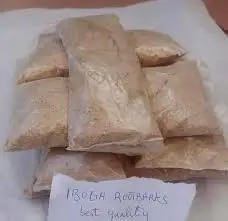Description
Ibogaine HCL – High-Purity Iboga Alkaloid for Research Use
Product Name: Ibogaine Hydrochloride (HCL)
Synonyms: 12-Methoxyibogamine HCl, Ibogaine Hydrochloride Salt
Molecular Formula: C20H27NO·HCl
Molecular Weight: 353.90 g/mol
CAS Number: 63492-69-3
Purity: ≥98% (HPLC)
Appearance: White to off-white crystalline powder
Intended Use: For laboratory research and chemical analysis only. Not for human consumption.
Product Overview
Ibogaine Hydrochloride (HCL) is a naturally occurring indole alkaloid derived from the root bark of the Tabernanthe iboga plant, native to West-Central Africa. This compound has attracted significant attention in the fields of neuroscience, pharmacology, and addiction research due to its unique psychoactive properties and potential therapeutic applications.
Ibogaine HCL is the hydrochloride salt form of ibogaine, offering enhanced stability and water solubility compared to its freebase counterpart. This makes it particularly suitable for controlled laboratory experiments and neuropharmacological research. With a high purity of ≥98%, our Ibogaine HCL is synthesized and tested under stringent laboratory conditions to ensure consistency, safety, and scientific reliability.
Chemical and Physical Properties
- Molecular Structure: Ibogaine HCL has a complex indole alkaloid structure, featuring a methoxy group at the 12-position and a nitrogen atom within a bicyclic system. This structure is responsible for its interaction with various neurotransmitter systems in the brain.
- Solubility: The hydrochloride salt form is soluble in water, methanol, and ethanol, slightly soluble in acetone and chloroform, and practically insoluble in ether. This solubility profile facilitates its use in aqueous solutions for laboratory applications.
- Melting Point: Ibogaine HCL decomposes at temperatures around 299–300°C, indicating its thermal stability under standard laboratory conditions.
- Optical Rotation: The compound exhibits levorotatory optical activity, with specific rotations of [α]D20 -53° in 95% ethanol and [α]D25 -63° in ethanol, providing a means for purity assessment and structural confirmation.
Pharmacology and Mechanism of Action
Ibogaine HCL exerts its effects through interaction with multiple neurotransmitter systems in the central nervous system:
- NMDA Receptors: Acts as a non-competitive antagonist, potentially modulating glutamate transmission and neuroplasticity.
- Opioid Receptors: Exhibits affinity for kappa- and mu-opioid receptors, which may underlie its purported anti-addictive effects.
- Serotonin Transporters (SERT): Functions as a serotonin reuptake inhibitor (SRI), possibly contributing to mood-enhancing properties.
- Dopaminergic Systems: Alters dopamine regulation in the mesolimbic system, a pathway associated with addiction and motivation.
Through this broad pharmacological action, ibogaine may promote a “reset” in brain chemistry associated with compulsive drug use, making it a compound of interest in addiction interruption studies.
Applications in Research
Ibogaine HCL is primarily utilized in studies relating to:
- Addiction Neuroscience: Investigation of ibogaine’s modulatory effects on opioid, stimulant, alcohol, and nicotine addiction.
- Neuropharmacology: Studies examining receptor interactions, neuroplasticity, and neurotransmitter modulation.
- Behavioral Pharmacology: Research exploring the psychoactive effects, behavioral resets, and anti-craving properties in preclinical models.
- Toxicology: Assessment of dose-response, safety margins, and potential cardiotoxicity.
Synthesis and Purity
Ibogaine HCL can be synthesized through various methods:
- Extraction from Tabernanthe iboga: The root bark of the plant contains approximately 6% indole alkaloids, including ibogaine, ibogaline, ibogamine, and tabernanthine. Ibogaine constitutes about 80% of this alkaloid content, making it the primary compound of interest for research purposes.
- Semi-Synthesis from Voacanga africana: Another approach involves the semi-synthesis of ibogaine from voacangine, an alkaloid derived from the Voacanga africana plant. This method allows for the production of ibogaine in regions where Tabernanthe iboga is not native.
- Total Synthesis: The first total synthesis of ibogaine was described in a US patent in 1956, and a detailed procedure was published by Büchi et al. in 1966. These synthetic routes have been refined over time to improve yield and purity.
Our Ibogaine HCL is synthesized under Good Laboratory Practices (GLP) and undergoes rigorous quality control measures, including high-performance liquid chromatography (HPLC) analysis, to ensure a purity of ≥98%. This high purity is crucial for reproducible and reliable results in scientific studies.
Safety and Handling
Ibogaine HCL is a research chemical and must be handled with appropriate safety precautions:
- Personal Protective Equipment (PPE): Laboratory personnel should wear gloves, lab coats, and safety goggles when handling ibogaine HCL.
- Ventilation: Work should be conducted in a well-ventilated fume hood to avoid inhalation of any dust or vapors.
- Storage: Store at room temperature, in a cool, dry place away from light. Recommended storage between 2–8°C for long-term preservation.
- Shelf Life: Stable for up to 24 months under recommended storage conditions.
- Toxicity: Ibogaine HCL may be harmful if swallowed, inhaled, or in contact with skin. It may cause central nervous system effects and should be handled with care.
Legal Status
The legal status of ibogaine varies by country:
- United States: Classified as a Schedule I controlled substance under the Controlled Substances Act, indicating a high potential for abuse and no accepted medical use.
- Canada: Ibogaine is not approved for medical use and is considered a controlled substance.
- Europe: The legal status varies by country, with some nations classifying ibogaine as a controlled substance and others allowing its use in specific contexts.
- Other Countries: In some regions, ibogaine is used in clinical settings for addiction treatment, while in others, it remains illegal.
Researchers should consult local regulations and obtain necessary permits before acquiring or using ibogaine HCL.
Conclusion
Ibogaine HCL is a potent and versatile compound with significant research potential in the fields of neuroscience, pharmacology, and addiction medicine. Its unique pharmacological profile and ability to interact with multiple neurotransmitter systems make it a valuable tool for understanding the complexities of addiction and exploring potential therapeutic interventions.
Our high-purity Ibogaine HCL is synthesized under stringent laboratory conditions to ensure consistency and reliability in research applications. It is intended strictly for laboratory research and not for human consumption. Researchers are advised to handle this compound with appropriate safety precautions and to comply with all applicable laws and regulations.
For additional data sheets, regulatory documentation, or bulk ordering inquiries, please contact our research chemical support team.



Reviews
There are no reviews yet.